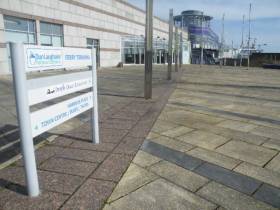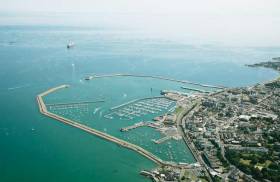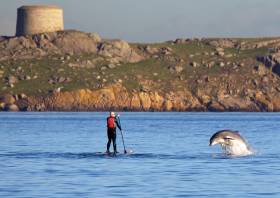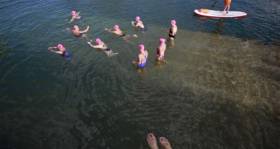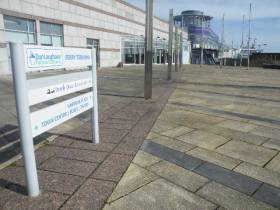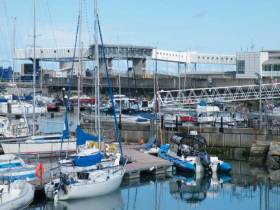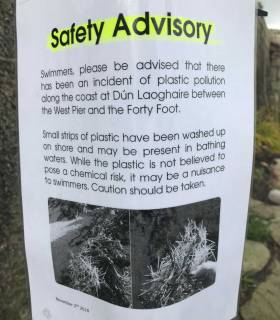Displaying items by tag: dlrcoco
Dun Laoghaire Harbour’s former chief executive Gerry Dunne received a redundancy payment of €670,000 from the local authority that now owns the harbour, it’s been reported.
According to East Coast FM, Dun Laoghaire-Rathdown county councillors were told at a 2020 budget meeting on Wednesday 6 November that a single payment of €670,000 in redundancy was made in line with Department of Public Expenditure guidelines, with no sign-off required.
Dunne had been CEO of the Dun Laoghaire Harbour Company from 2009 until it was dissolved last year upon the harbour’s transfer to local authority hands.
Dun Laoghaire-Rathdown County Council have engaged L&M Keating Ltd to carry out further repairs to the end of the West Pier and behind the sun shelter on the East Pier of Dun Laoghaire Harbour.
The works include repairing damage to the revetments, and replacing rock armour removed by Storm Emma in March 2018. The council expects these works to be completed by Christmas.
Members of the public are requested to obey safety signage and stay clear of the works areas on both piers.
Afloat.ie understand that a budget shortfall resulting from a lower than expected insurance payout over damage sustained during Storm Emma means that some works, unclosing the rebuilding of the East Pier’s sun shelter, cannot be completed at this time.
The chief executive of Dun Laoghaire’s local authority has said she was “stunned” the transfer of the town’s harbour to its control did not come with any State funding to offset its debts.
The Irish Times reports on a special meeting of Dun Laoghaire-Rathdown County Council yesterday evening (Monday 30 September) on the eve of the first anniversary of its taking over responsibility for the harbour.
That move also saw the authority assume €38 million in “infrastructural debt costs”, with Transport Minister Shane Ross confirming months beforehand that the transfer would include “all assets and liabilities”, with no additional State funding made available.
“National Ports Policy recognised that the future of Dun Laoghaire port lies in marine leisure, marine tourism, cultural amenity and urban redevelopment,” the minister stated at the time. “In addition, it clearly states that there is no Exchequer finding for any port company.”
Local councillors expressed their frustration upon the formal changeover a year ago, and the same issues were reiterated yesterday — with the council’s director of services Therese Langan telling the meeting that €10 million in “immediate works” was required.
This includes remedial works as a result of “substantial damage” to the East Pier during Storm Emma early last year.
“No funding was provided in spite of the case being forcefully put as to the financial burden being placed on a single local authority,” Langan told the council.
Chief executive Philomena Poole said she would have welcomed a commitment for State funding “but I didn’t get one”.
With the additional debts and council funding shortfall, a number of plans for the harbour including a €5 million urban beach and a €30 million cruise berth have been pulled. Proposals for an 'innovation campus' at the former ferry terminal also fell apart.
The council more recently opened a tender for expert strategic advice on an economic plan for the harbour and adjacent town centre. The former has struggled since losing the Stena Line ferry service to Holyhead almost five years ago.
The Irish Times has much more on the story HERE.
Climate Action Report Claims Dublin Bay Sea Level Rising Faster Than Forecast
Dublin Bay’s sea level seems to be rising faster than forecast — and at twice the global average over the past two decades.
The Irish Times reports on this startling claim from Dun Laoghaire-Rathdown County Council’s (DLRCoCo) climate change action plan, which also notes that weather extremes are “likely to increase in their frequency and intensity”.
The report comes following one of Ireland’s hottest summers on record, itself just months after a first ever Status Red warning for snow was issued by Met Éireann.
Three Dublin local authorities launched their climate action plans on Monday (9 September), with DLRCoCo’s plan pledging to “prioritise nature-based flood defences where possible” over the next five years.
The Irish Times has much more on the story HERE.
Dun Laoghaire Council Seeks Tenders On Strategy For Harbour & Town
Dun Laoghaire-Rathdown County Council is inviting tenders for expert economic and strategic advice for Dun Laoghaire Harbour, which came under its control late last year.
The request for tenders (RFT), which is open until Tuesday 17 September, says the local authority is “seeing expert advice on the development of the harbour for the benefit of its citizens”.
The move comes three months after the authority withdrew controversial plans for a €30 million berth for cruise liners in the harbour, as previously reported on Afloat.ie.
A separate RFT also seeks “expert economic, spatial and strategic advice” for Dun Laoghaire’s town centre adjacent to the harbour.
“In recent times, development in the town has been largely focused on increasing residential capacity with a consequential decrease in the amount of small-scale commercial office floor space available for employment uses locally and a reduction in the overall number of jobs located within the town,” the local authority says.
It adds that the Government’s Urban Regeneration and Development Fund “provided an opportunity for Dun Laoghaire-Rathdown County Council through a Category B application to carry out a study of the economic profile of the town, examine the changing nature of office-based development, make recommendations in relation to future potential economic opportunities and identify infrastructure deficits that exist in the town”.
Relevant documents for each RFT are available to download from the official links above (login required).
Council Launches Online Visitor Survey For Dalkey Island
Dun Laoghaire-Rathdown County Council is currently carrying out a visitor survey for Dalkey Island to assist in the long-term management and protection of a key historical and ecological site in Dublin Bay.
Dalkey Island, which is owned by the council, is a part of the Dublin Bay Biosphere, and is home to a significant colony roseate terns, not to mention seals, rabbits and wild goats.
The island has also been an important site of pilgrimage for many centuries, and was previously knows as St Begnet’s Isle.
The online survey aims to quantify the number of visitors and the quality of their experience. It will only take a few minutes to complete, and is available HERE.
Dún Laoghaire Harbour €86m Projects in Doubt
#dublinbay - Multimillion-euro projects planned for Dún Laoghaire Harbour, reports The Irish Times, have been thrown into question, including a €5 million urban beach, a €51 million diaspora centre, and a €30 million cruise berth facility.
Dún Laoghaire-Rathdown County Council has said there is no money for many, if not all, of the plans in advance of the publication of a new economic study on the viability of the proposals.
The proposals were put forward by the Dún Laoghaire Harbour Company, which no longer operates the harbour.
The council took control of the harbour last year at the behest of Minister for Transport Shane Ross. The decision left many councillors unhappy, as the Minister did not provide funding to meet the estimated €30 million cost of carrying out structural repairs at the harbour.
In a progress report on integrating the harbour into the local authority which was presented to councillors on Monday night, council management said there was no money for many of the projects proposed for the harbour.
However, council management also said it had secured Government funding under the Urban Regeneration and Development Fund to draw up a “spatial and economic action study” which would make recommendations in relation to “potential economic opportunities for the town of Dún Laoghaire, including the harbour”.
Further reading on the story can be made by clicking here.
Expressions of Interest Sought by Council for Dún Laoghaire Ferry Terminal
#dublinbay - New expressions of interest will be sought by Dún Laoghaire-Rathdown County Council for the former Stena Line ferry terminal site after a €20 million plan to convert it into a technology hub stalled late last year.
“Dún Laoghaire-Rathdown will be seeking expressions of interest for the development of the ferry terminal building in the next few weeks. Information sought will include production of a robust business plan and adequate proof of funding for the first three years of the project,” a spokeswoman for the local authority told The Irish Times.
The council is seeking expressions from consortiums, businesses, commercial interests, entrepreneurs or other individuals who will “develop and manage the property and offer space to the business sector while providing a positive economic impact for Dún Laoghaire town”.
Estate agent Lisney has been appointed to find an occupier. The building has a 10-year planning permission with an option to extend for a further period of five years.
Investor Philip Gannon had been leading a plan to transform the empty terminal into a 7,000 square metre digital hub, but last October pulled out of the project. Mr Gannon terminated his lease on the site after issues emerged over the lack of a foreshore licence needed to develop the property correctly.
The technology investor Ian Lucey had also been involved in the project to develop the terminal, but relations between him and Mr Gannon broke down some time ago. Mr Lucey has expressed an interest in continuing to be involved in the development if possible.
For much more on The Irish Times story, click here.
Cruise Service Bid Competes With New Tech Hub Plans For Dun Laoghaire Ferry Terminal
Speculation that a ferry service could return to Dun Laoghaire has reached fever pitch with the news that a British company has put in a bid to operate from the St Michael’s Pier terminal.
According to The Times, the Liverpool & North Wales Steamship Company, which was restarted two years ago, envisages running regular passenger cruises in the Irish Sea and will be “ready to sail” from next summer.
The ferry company’s chief executive Steve Payne plans to present his pitch to Dun Laoghaire-Rathdown County Council — the authority that now controls the harbour — by the end of this year, laying out plans for services that could employ 240 people.
Payne revealed to Afloat.ie that as well as the cruise bid involving its 650-passenger vessel, it also wants to operate a regular ferry service serving its home base of Liverpool and also Llandudno in North Wales.
The company’s flagship heritage pleasure steamer TSMV Endeavour is presently in refit in Liverpool.
However, one of the investors involved in the recently scrapped Harbour Innovation Campus proposal says he intends to push on with a tech hub scheme for the former ferry terminal.
Ian Lucey currently faces a High Court action from Harbour Innovation Campus developer Philip Gannon in a case that’s understood to be separate from Gannon’s decision to pull out of the Dun Laoghaire venture last month.
Note: This piece has been corrected to remove a previous statement that Philip Gannon and Ian Lucey were business partners. The shareholder agreement clearly states that no partnership was created. We are happy to make this clarification.
Safety Advisory For Swimmers Over Plastic Pollution At Forty Foot
#Safety - Dun Laoghaire-Rathdown County Council has posted a safety advisory for swimmers in Dun Laoghaire over an incident of plastic pollution between the West Pier and the Forty Foot.
According to the local authority, “small strips of plastic” that have washed ashore in recent days may be present in bathing waters.
While the plastic poses no chemical danger, it could be a nuisance or at worst a physical risk to swimmers.
As The Irish Times reports, contractors working on the redevelopment of the Dun Laoghaire baths site are launching a clean-up operation in the affected area after “a quantity of fibres” was washed into the water during a concrete pour.
It follows community efforts led by local environmental hero Flossie Donnelly, who recently donated a second Seabin for cleaning surface debris in Dun Laoghaire Harbour to the National Yacht Club.





























